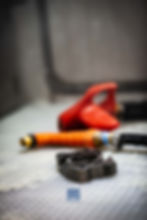Is Wetblasting better than Dryblasting?
- Precision Finishing Inc.
- Aug 29, 2019
- 3 min read
Wet blast machines are becoming more and more popular, but what are the differences between dry blast and wet blast? To understand why we use either process we need to look at the specifics of what we are trying to achieve.
The Wet Blast Process :
The use of liquid in a blasting process gives us the “wet blast” designation, and most wet
blast machines will handle “standard” mineral-based and glass blasting abrasives. Delivery methods may vary, however, the general principle applied is a stream of a “slurry”, consisting of abrasive and liquid, which is met by compressed air thus propelling the slurry at an increased velocity through a nozzle. When a particle of abrasive impacts the surface of the substrate, the liquid reduces the severity of impact and will aid in carrying away surface contamination. The combination of these principles create a clean surface and generally “brighter” surface condition then it's dry blast counterpart if process parameters remain the same between wet and dry processes. Filtration of the liquid in the blast machine needs to be managed carefully as the soils from the parts are suspended in the liquid. Process times generally increase when in wet blast machines due to the liquid reducing the impact of abrasive. This can also prolong the life of the media. Few standard wet blast machines can utilize abrasive reclamation. As the media breaks down, the fines and shards will remain in your abrasive slurry which will change the finish over time.
The Dry Blast Process :
Dry blast machines use compressed air as the main method of abrasive transmission.
Cabinets consist of two main categories - direct pressure and suction. Both principals introduce abrasive into the compressed air stream which is then propelled at the part substrate through a nozzle, however, delivery methods are very different.
“Suction Cabinets” literally use suction to draw abrasive into the air stream. A blast gun will have a cavity somewhere in the gun used to generate negative pressure by way of venturi, and draw abrasive through a hose from a hopper or reclaim. The abrasive is then propelled through a nozzle at the substrate being blasted.
A “Direct Pressure” system starts by pressurizing a media filled pressure vessel, hence the name. The pressurized vessel introduces the media to a compressed air line through a media regulator, or “grit valve”, then travels through a length of hose to a nozzle. Since we are now pushing media, (instead of drawing it in) you will find a significant increase in media volume and impact velocity, making direct pressure systems two to four times more efficient than suction cabinets.
The Take-Away :
Application specificity is what we should be looking at.
Wet blast cabinets are great for cleaning dirt, grime, grease, and aesthetic prowess, however, you need to monitor the slurry for contamination, process times will increase vs. dry blast, and “off-the-shelf” models will not likely have any form of media classification and reclamation. Media life will be longer than dry blast but a 100% media change will be necessary after a long stint of blasting.
Dry blast cabinets give you options for media recovery and classification, increased process speed, and no need for part drying. Dry blasting is not well suited for dirty and oily parts, resulting in media and cabinet contamination, however, the continual removal of broken media maintains a high level of finish consistency over a long production period.
If you want to see the difference for yourself come visit us!
We have all the styles of equipment operating continuously in our finishing facilities. Bring some parts in and we can give you the opportunity to try them out for yourself! Our process development team can guide you through the sampling process as well as recommend abrasives, pressures, distances, or even process the job for you without capital expense.





